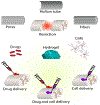Minimally Invasive and Regenerative Therapeutics
- PMID: 30565732
- PMCID: PMC6709364
- DOI: 10.1002/adma.201804041
Minimally Invasive and Regenerative Therapeutics
Abstract
Advances in biomaterial synthesis and fabrication, stem cell biology, bioimaging, microsurgery procedures, and microscale technologies have made minimally invasive therapeutics a viable tool in regenerative medicine. Therapeutics, herein defined as cells, biomaterials, biomolecules, and their combinations, can be delivered in a minimally invasive way to regenerate different tissues in the body, such as bone, cartilage, pancreas, cardiac, skeletal muscle, liver, skin, and neural tissues. Sophisticated methods of tracking, sensing, and stimulation of therapeutics in vivo using nano-biomaterials and soft bioelectronic devices provide great opportunities to further develop minimally invasive and regenerative therapeutics (MIRET). In general, minimally invasive delivery methods offer high yield with low risk of complications and reduced costs compared to conventional delivery methods. Here, minimally invasive approaches for delivering regenerative therapeutics into the body are reviewed. The use of MIRET to treat different tissues and organs is described. Although some clinical trials have been performed using MIRET, it is hoped that such therapeutics find wider applications to treat patients. Finally, some future perspective and challenges for this emerging field are highlighted.
Keywords: biomaterials; biomolecules; delivery; minimally invasive; scaffolds; tissue regeneration.
© 2018 WILEY-VCH Verlag GmbH & Co. KGaA, Weinheim.
Figures













Similar articles
-
Advances in Regenerative Medicine and Biomaterials.Methods Mol Biol. 2023;2575:127-152. doi: 10.1007/978-1-0716-2716-7_7. Methods Mol Biol. 2023. PMID: 36301474
-
Smart bioelectronic materials and systems for regenerative tissue engineering.Biomaterials. 2025 Dec;323:123427. doi: 10.1016/j.biomaterials.2025.123427. Epub 2025 May 21. Biomaterials. 2025. PMID: 40435815 Review.
-
The Potential Application of Biomaterials in Cardiac Stem Cell Therapy.Curr Med Chem. 2016;23(6):589-602. doi: 10.2174/092986732306160303151041. Curr Med Chem. 2016. PMID: 26951086 Review.
-
Poly (lactic acid)-based biomaterials for orthopaedic regenerative engineering.Adv Drug Deliv Rev. 2016 Dec 15;107:247-276. doi: 10.1016/j.addr.2016.04.015. Epub 2016 Apr 25. Adv Drug Deliv Rev. 2016. PMID: 27125191 Free PMC article. Review.
-
Decellularized scaffolds in regenerative medicine.Oncotarget. 2016 Sep 6;7(36):58671-58683. doi: 10.18632/oncotarget.10945. Oncotarget. 2016. PMID: 27486772 Free PMC article. Review.
Cited by
-
Hybrid gelatin/oxidized chondroitin sulfate hydrogels incorporating bioactive glass nanoparticles with enhanced mechanical properties, mineralization, and osteogenic differentiation.Bioact Mater. 2020 Oct 6;6(3):890-904. doi: 10.1016/j.bioactmat.2020.09.012. eCollection 2021 Mar. Bioact Mater. 2020. PMID: 33073063 Free PMC article.
-
Room-Temperature-Formed PEDOT:PSS Hydrogels Enable Injectable, Soft, and Healable Organic Bioelectronics.Adv Mater. 2020 Jan;32(1):e1904752. doi: 10.1002/adma.201904752. Epub 2019 Oct 28. Adv Mater. 2020. PMID: 31657081 Free PMC article.
-
Bioinks and bioprinting technologies to make heterogeneous and biomimetic tissue constructs.Mater Today Bio. 2019 May 25;1:100008. doi: 10.1016/j.mtbio.2019.100008. eCollection 2019 Jan. Mater Today Bio. 2019. PMID: 32159140 Free PMC article. Review.
-
Minimally invasive implantation and decreased inflammation reduce osteoinduction of biomaterial.Theranostics. 2020 Feb 18;10(8):3533-3545. doi: 10.7150/thno.39507. eCollection 2020. Theranostics. 2020. PMID: 32206106 Free PMC article.
-
Trans-Vessel Wall Cell Transplantation, Engraftment, and Tumor Access in the VX2 Rabbit Model.Cell Transplant. 2025 Jan-Dec;34:9636897251313678. doi: 10.1177/09636897251313678. Cell Transplant. 2025. PMID: 39871454 Free PMC article.
References
-
- He W, Goodkind D, Kowal P, An Aging World: 2015, International Population Report No. P95/16–1, United States Census Bureau, Washington, DC, USA: 2016.
-
- Montgomery M, Ahadian S, Davenport Huyer L, Lo Rito M, Civitarese RA, Vanderlaan RD, Wu J, Reis LA, Momen A, Akbari S, Pahnke A, Li R-K, Caldarone CA, Radisic M, Nature Materials 2017, 16, 1038. - PubMed
-
- Krettek C, Schandelmaier P, Nliclau T, Tscherne H, Injury 1997, 28, A20. - PubMed
Publication types
MeSH terms
Substances
Grants and funding
- U01 CA214411/CA/NCI NIH HHS/United States
- R01 HL140951/HL/NHLBI NIH HHS/United States
- R01 EB023052/EB/NIBIB NIH HHS/United States
- R01 AR066193/AR/NIAMS NIH HHS/United States
- EB023052/NH/NIH HHS/United States
- R01 EB024403/EB/NIBIB NIH HHS/United States
- EB021857/NH/NIH HHS/United States
- CA214411/NH/NIH HHS/United States
- EB024403/NH/NIH HHS/United States
- R21 EB022403/EB/NIBIB NIH HHS/United States
- HL137193/NH/NIH HHS/United States
- AR066193/NH/NIH HHS/United States
- R01 AR057837/AR/NIAMS NIH HHS/United States
- AR057837/NH/NIH HHS/United States
- R01 AR073135/AR/NIAMS NIH HHS/United States
- EB022403/NH/NIH HHS/United States
- FA9550-15-1-0273/Air Force Office of Sponsored Research
- R01 EB021857/EB/NIBIB NIH HHS/United States
- R01 HL137193/HL/NHLBI NIH HHS/United States
LinkOut - more resources
Full Text Sources
Other Literature Sources

